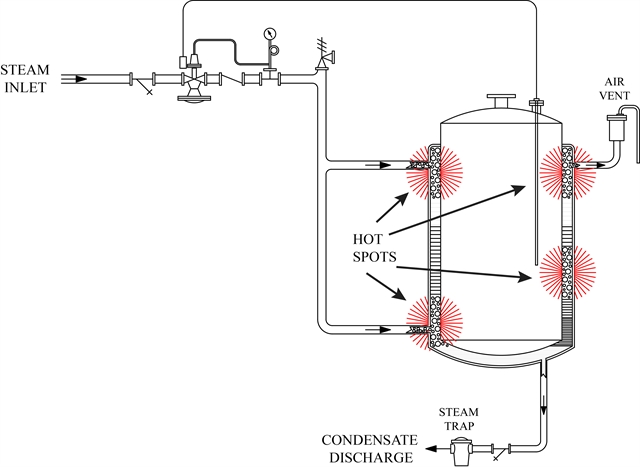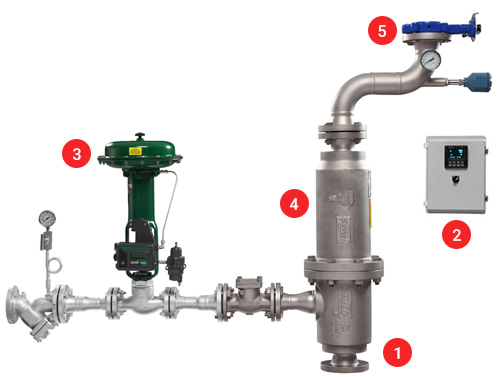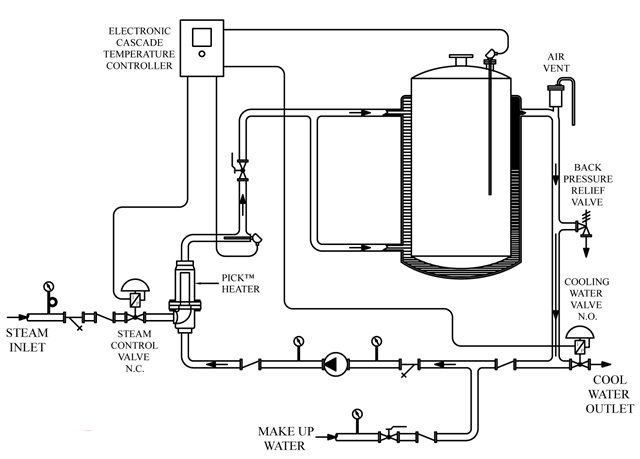Jacketed heating is widely used in process plants to heat devices such as tanks, kettles, dryers, reactors and glass-lined vessels that operate at temperatures up to 350° F.
In these applications, steam heating is often the first option considered by designers. Steam has several obvious advantages: it is readily available and easy to apply, it provides quick heat-up and it is predictable. For example, 100 PSIG saturated steam is always 338° F, with 1,189 BTU/lb total heat content.
Despite these desirable attributes, steam presents several problems for jacketed heating applications. For example, it does not offer precise temperature control. In addition, the transfer of energy is not uniform, commonly resulting in hot spots as shown in Figure 1. Hot spots around the jacket increase the likelihood for product burn-on and local overheating.

Figure 1: Heating a jacketed heating using steam often results in internal hot spots that cause uneven product heating.
Reactions requiring both heating and cooling present other issues. At the conclusion of the heating cycle, all steam and condensate must first be driven out of the jacket before cooling water can be added; contact between the hot steam and the cool water can cause thermal shock and steam hammer that could be catastrophic for glass-lined reactors.
As a result of these disadvantages, many system designers are switching from steam to hot water for their jacketed-heating applications. Operating temperatures can exceed water’s sea-level boiling point of 212° F if the water is pressurized.
Hot water heating solves some of the problems caused by steam, including:
There are a few downsides to hot water heating. For instance, the heat-up time is not as rapid as with steam. In addition, the jacket water temperature cannot equal or exceed the saturated temperature of the steam supplied to the system to prevent the water flashing back into steam.
Steam still has an important role to play in jacketed heating. A Direct Steam Injection (DSI) Heater provides the most precise and energy-efficient method for heating the jacket water to the desired temperature. A DSI System operates by injecting steam directly into the water for an efficient transfer of heat – 100% of the available energy from the steam is instantly absorbed by the liquid.
The tremendous amount of energy available in the steam makes it imperative that the energy be dissipated quickly into the fluid to maintain stability. The Pick DSI Heater accomplishes this by dispersing the steam in many fine streams through precisely arranged orifices for rapid mixing and instantaneous heat transfer. As the steam enters the internal injection tube, it acts against a spring-loaded piston to expose some or all of the pattern formed by the orifices. As the steam input varies due to load changes, the piston modulates to adjust the number of exposed orifices, providing rapid response to process changes.

Figure 2: The Pick Constant Flow Heater design allows for rapid mixing and instantaneous heat transfer.
The spring-and-piston arrangement prevents equalization of steam and liquid pressures, eliminating harmful shock and vibration. The helical flights inside the chamber ensure complete and thorough mixing of steam and liquid.
Advantages of DSI to heat water in a jacketed heating design include:
Figure 3 shows a jacketed system design that includes a DSI Heater. Many industries take advantage of jacketed heating and DSI; the food industry, for example, commonly uses jacketed kettles to heat scorch-sensitive products such as beverages, soups and sauces. A DSI Heater controls the jacket temperature to ±1° C, eliminating the risk of heat-related spoilage from burn-on. In addition, the chemical and pharmaceutical processing industries rely on jacketed heating for viscosity reduction in heavy liquids, and precise heat to begin an exothermic reaction.

Figure 3: A jacketed heater system that uses hot water in conjunction with DSI heating.
Water is superior to steam for heating jacketed reactors because it eliminates hot spots and uneven heating, allowing smooth transitions from heating to cooling with no thermal shock. DSI is superior to other methods for heating water due to its responsiveness, accurate temperature control and economical operation.
Pick Heaters offers a portfolio of DSI products for jacketed-heating applications that require a relatively constant flow of heated liquid at a precisely controlled temperature. The Pick Constant Flow Direct Steam Injection Heater is ideally suited for closed-loop applications where the flow rate is fixed or varies over a narrow span (3:1), or where variations in flow are gradual and rapid on/off cycling does not occur.
For more information - contact us.